You're using an outdated browser. Please upgrade to a modern browser for the best experience.
Please note this is a comparison between Version 1 by Mohammadali Shirinbayan and Version 2 by Catherine Yang.
Face masks can protect humans through their filtration function. They include different types and mechanisms of filtration whose performance depends on the texture of the fabric, the latter of which is strongly related to the manufacturing method.
- face mask
- medical devices
1. Types of Applied Materials in Face Mask Production
Generally, in various investigations, it was explained that most starting materials for face mask fabrication include non-woven materials such as polypropylene, glass papers and woolen felt, which have been proven to have special characteristics such as high-temperature resistance in autoclaving while serving a stable structure and cost-effective final product [1][2][10,11]. Furthermore, disposable non-woven fabrics are another useful type of non-woven material that have gained attention due to the lower risk of contamination in comparison with other materials. In this regard, a comparison of some characteristics of this type with reusable materials was performed, as shown in Table 1. Reusable fabrics could also be sterilized for secondary applications [3][12].
| Characteristic | Disposable Non-Woven | REUSABLE | |
|---|---|---|---|
| Traditional Textile | Micro-Porous Textile | ||
| Mechanical behavior | 1 | 2 | 3 |
| Resistance to bacterial penetration | 3 | 1 | 2 |
| Resistance to liquid penetration | 3 | 1 | 2 |
| Flexibility | 3 | 1 | 2 |
| Remark: 1–3 represent poor to best criteria of properties. | |||
However, generally speaking, usual applicable polymers in face mask production are polypropylene, polyethylene, polyesters, polyamides, polycarbonates, polyphenylene oxide and trifluorochloroethylene. Besides, some materials are applied together for better achievement of properties such as using polypropylene that is treated with dimethyl-dioctadecyl-ammonium bromide to improve bacterial attraction in order to import positive electrical charges [4][1].
Characteristic of Non-Woven Fabrics
Based on previous explanations, most non-woven materials are disposable and single-use; however, the second group needs sterilization before reuse. Nevertheless, there are some advantages and limitations to the application of non-woven materials. The main characteristic of these materials is the low cost of the final product. Furthermore, their permeability to air and non-adherence to wounds makes them an excellent dressing material [5][6][13,14]. Nevertheless, the term “single-use” is a limitation regarding their low resistance and poor drape ability in consideration of disposable non-woven materials [7][15]. At this stage, non-woven materials consist of various characteristics, which are listed below, and affecting the mask structure:
Fiber bonding. Non-woven materials are usually fabricated by the addition of an external chemical binder. Mechanical bonding has a negligible effect on the absorbency of fibers since inherent characteristics are not involved in this type of bonding. Yet, mechanical bonding causes two changes in the entanglement of fibers. First, the entanglement could limit the natural ability of the whole structure to swell. Second, the structure may prevent collapse in presence of external pressure. Considering these changes, mechanical bonding influences the capillary absorption of fluid [7][8][15,16].
Web assemblage. The manner of fiber arrangement to form a structure has a significant influence on the web properties, including packing, capillary orientation, pore size, capillary dimensions, etc. The absorbency of non-woven fibers is considered to be affected by their arrangement as well. Localized rearrangement of fibers also fulfills web formation and increases the wicking abilities of fabric [7][8][15,16].
Web finishing. In the nonwoven method, the fibers are assembled into the final structure and bonded by chemical or physical means. The absorbency of the nonwoven compound increases by chemical finishing since it modifies the wetting performance of a fiber surface and, as a result, affects the capillary behavior. Mechanical softening treatments can affect web properties and absorbency characteristics since fiber crimp could have an influence on packing efficiency and the resulting structure [5][6][13,14].
Fiber finishing. Fiber finishing is used to improve fiber’s processing performance within the equipment utilized for the transformation of fibers into a web. Since the finishing is on the surface of the fibers, it can influence wetting and liquid wicking and can have a direct impact on absorbency. Other morphological features such as surface rugosity and core uniformity can, in some cases, affect absorbency. In addition, the performance requirements in the fabrication of non-woven materials involve an optimization of different properties: liquid interaction, fabric flexibility and air permeability, and tensile properties [8][16].
2. Classification of Face Masks
Different classifications of face masks based on the application, materials and methods of production are presented. However, Table 2 shows different types of face masks with respect to their categories and relative properties.
| Types | Pros and Cons | Appearance |
|---|
| Basic Cloth face masks | Easily fabrication, cost-effective and simplest type of face mask. The starting materials could be clothes sweatshirts, T-shirts, etc. However, not much applicability for aerosols with diameters of 20–1000 nm compared to the other types. | 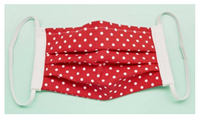 |
| Surgical face masks (SFMs) | This type serves the wearer for protection against fluid stream and bacteria capturing. It has three layers, with a role of filtering media, moisture absorbance, and water repelling. The effectiveness of this type is similar to the N95 respirator. However, they are not capable of reducing the emission of small-size droplets. |
Breathing resistance: This is used to determine the resistance of airflow through the masks. The SFM is subjected to a controlled flow of air. A lower breathing resistance illustrates a better comfort level to the end-user. The following sections will provide more information about this test.
Quality evaluation: This controls the quality evaluation to avoid transmission diseases, and the critical requirements are performed before the marketing of SFMs. For example, one of the important parts of the quality evaluation is the investigation of toxicity and biocompatibility of the masks. Sipahi et al. [15][23] studied the biocompatibility of eight marketed masks with different brands through their cytotoxicity and inflammation-inducing capacity. They showed that widely used disposable medical masks induced a surprisingly high rate of cytotoxicity and inflammation. In addition, they showed that evaluation of inflammation with cytotoxicity can be used to study the biocompatibility of medical devices such as with surgical masks.
Based on the mentioned classifications, there are three main levels of protection for SFMs that are indicated in Table 3.
Table 3.
ASTM F2100-11 levels of protection in SFMs.
| Level of Protection | Characteristic of Each Level |
|---|
| Level 1 (Low barrier) |
| |||
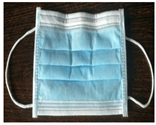 |
||||
|
N95 respirator | Known as electrets filters in the group of filtering facepiece respirators (FFR), with surgical and standard sorts, they filter particles with diameters of 0.3 µm with 95% efficiency. It has a ventilator fan and four layers of materials of non-woven polypropylene for outer/inner layers and modacrylic, non-woven polypropylene metlblown for middle ones. However, N95 respirators are not applicable for sufficient protection against aerosols with diameters of less than 300 nm. | 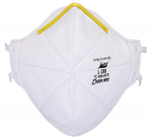 |
Table 4 5 presents the needed terms of SFMs for acceptable performance.
Table 45.
Demands for the excepted performance of medical face masks (EN 14683:2019+AC:2019).
| Evaluation | Type I | a | Type II | a | Type IIR | b |
|---|---|---|---|---|---|---|
|
| Bacterial filtration efficiency (BEF), % | |||||||||
| ≥95 | ≥98 | ≥98 | Level 2 (Moderate barrier) |
| |||||
| Differential pressure (Pa·cm | −2 | ) | <40 | <40 | <60 | Level 3 (High barrier) |
| ||
| P100 respirator/gas mask | This is another type of filtering facepiece respirator (FFR), with a particle-filtering efficiency and penetration of 99.97% and 0.03%, respectively. In addition, this type is better than N95 respirators in terms of less leakage and keeping a standard form in changing temperature and humidity. |  |
|||||||
| Self-contained breathing apparatus (SCBA) | This type of mask is equipped with an air supply that is normally applied for firefighting protection that resists forms of airborne contamination. However, it limits the mobility of the user and restricts workplace moments. | 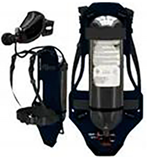 |
|||||||
| Full face respirator | This is made from rigid plastic materials with transparent parts for observation, which are fabricated for the aim of breathing trouble treatment. There are different types with respect to the size and shapes: air-purifying respirators (APR) and atmosphere-supplying respirators (ASR). Face supplies for holding the masks are made of adaptable elastomeric materials to well cover the face. Another element is straps that hold the mask body on the user head for the aim of leakage prevention. However, based on wearer behavior, these elements, especially the straps, can be broken. | 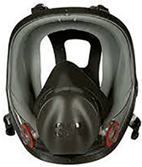 |
|||||||
| Full-length face shield | This kind of mask contains elastic headbands to cover the head and a transparent rigid polymeric (polycarbonate) full-length face shield. This could protect the user from liquid infected splashes in sneezing. |  |
Due to the COVID-19 consequences and application of the SFMs in different departments, categories of these types are discussed more. According to the ASTM F2100-11 standard, SFMs are generally categorized into three main groups: Level 1 (low) barrier, Level 2 (medium) barrier, and Level 3 (high) barrier. Level 1 has the lowest barrier of protection, while Level 3 has the highest barrier of protection. There are different criteria that have been implemented into the classification of SFMs:
Bacterial filtration efficiency (BFE): This criterion is designed for measuring bacterial filtration efficiency of SFMs using Staphylococcus aureus as the challenge organism. Staphylococcus aureus is based on its clinical relevance as a leading cause of nosocomial infections. A higher bacterial filtration efficiency percentage indicates a better protection level for the patient and healthcare professionals against transmission diseases from the source of the patient and healthcare professionals.
3. Standards in Quality Controls of Face Masks
Currently, due to this unrecognized virus (COVID-19), companies have produced a vast variety of masks; furthermore, minding the standards are essential. For this, the required information about the most important standards should be covered. The standard of “EN 14683:2019+AC:2019” is attributed to medical face masks (i.e., requirements and test methods), with the scope of construction, design, performance requirements and test methods for medical face masks that aim to decline the transition of ineffective agents from staff to patients.
| Splash resistance pressure (kPa) | |||||
| NR * | NR | ≥16.0 | |||
| Microbial cleanliness (cfu. g | −1 | ) | ≤30 | ≤30 | ≤30 |
* not required. a Classified as bacterial filtration efficiency, which is “type I” and should only be used for patients and other persons to limit infections spreads. b This type is divided with respect to splash resistance “R”.
